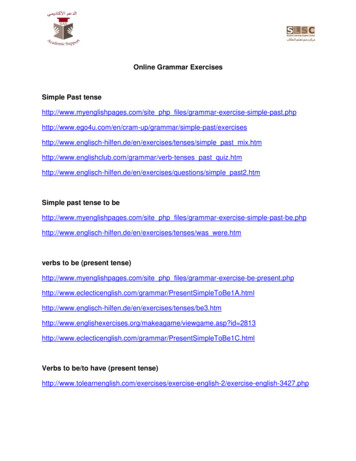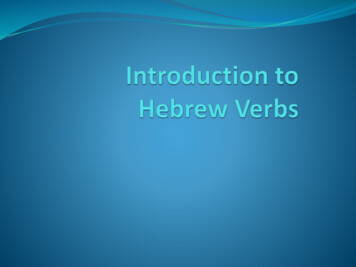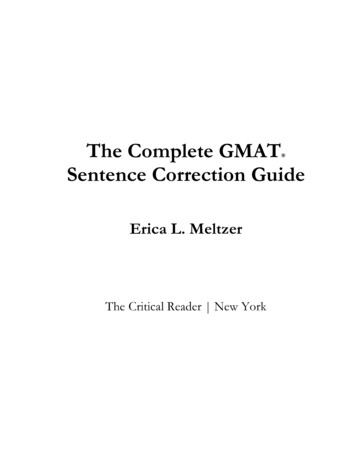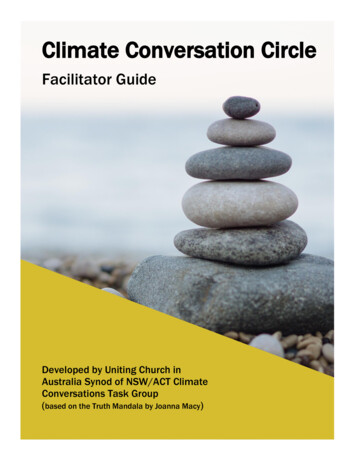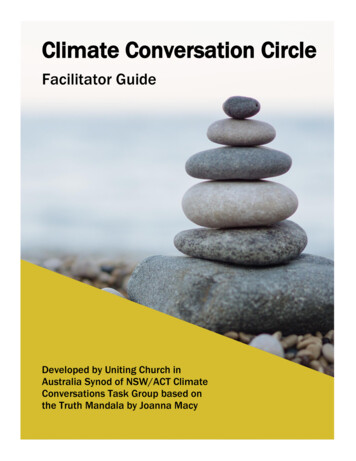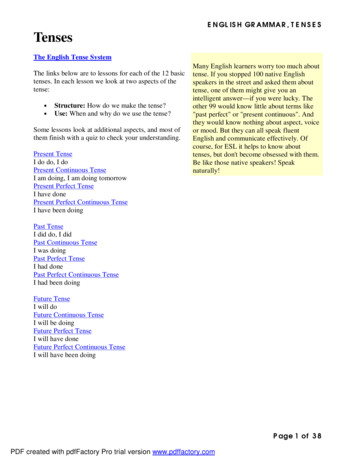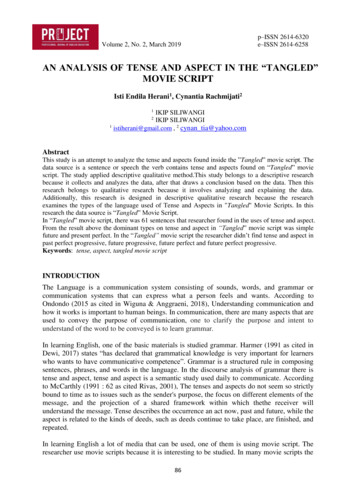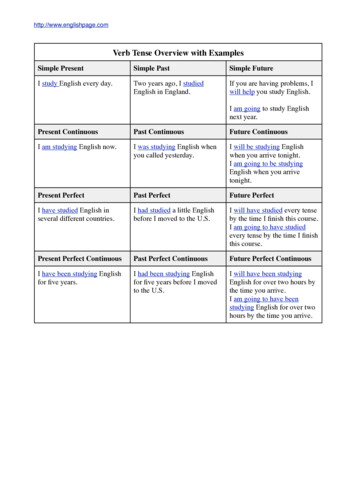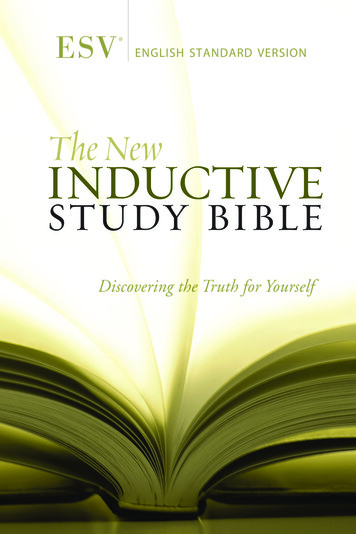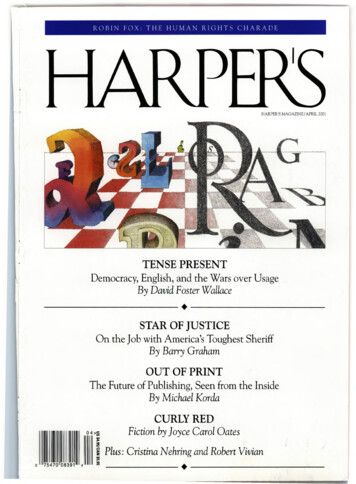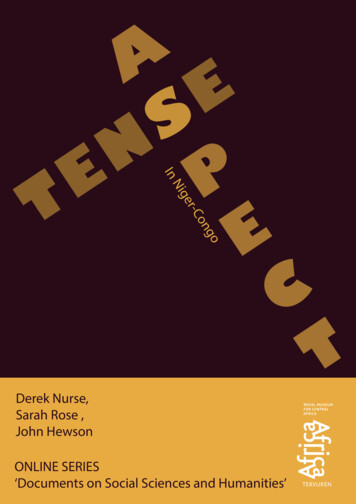
Transcription
InAESNEPTEongor-CgeNiCDerek Nurse,Sarah Rose ,John HewsonONLINE SERIES‘Documents on Social Sciences and Humanities’T
Cover: Bram de Rudder (RMCA).ISBN: 978-9-4922-4429-1Legal Deposit: D/2016/0254/10 Royal Museum for Central Africa, 201613, Leuvensesteenweg3080 Tervuren, Belgiumwww.africamuseum.beThis work is licensed under a Creative Commons Attribution 3.0 License mation about this publication: Publications Service, Royal Museum for Central Africa,13 Leuvensesteenweg, 3080 Tervuren (Belgium).publications@africamuseum.be
TENSE AND on(withcollaborationfromChristaBeaudoin-Lietz)
List of , the Niger-Congo languages, the choice of languages0.2.1 Language sampleThe structure of the book and of the chaptersMorphosyntactic background0.4.1 Word order in Niger-Congo0.4.2 The structure(s) of verbs in Niger-Congo0.4.3 Serial verbsChapter 1 Aspect and Tense1.11.21.3Aspect1.1.1 Perfective, Perfect and Factative1.1.2 IncompletivesTense1.2.1 Aspect and tense1.2.2 Aspect systems and “future tense(s)”1.2.3 Tense systemsA brief note on terminology Sarah RoseChapter 2 Aghem2.12.22.32.42.52.62.72.8GeneralWord OrderVerb structureTense, aspectOther categoriesNegation‘Be’ and ‘have’, and sources for other formativesBamileke-DschangChapter 3 Bambara3.13.23.33.43.53.63.73.83.93.10GeneralWord OrderVerb structureAuxiliariesParticiplesPrefixes and suffixesMoodNegativesRelativesConclusion3
Chapter 4 Bantu Narrow4.14.24.34.44.54.64.7GeneralWord OrderVerb structureTense, aspectOther categories: relative, mood, focusNegationAuxiliariesChapter 5 Bijago5.15.25.35.45.5GeneralWord OrderVerb structureMultiple verb constructionsNegativesChapter 6 Degema6.16.26.36.46.56.66.7GeneralWord orderVerb structureAspectMoodAuxiliariesNegationChapter 7 Donnɔ Sɔ (Dogon)7.17.27.37.47.57.67.77.87.9GeneralWord orderVerb structureParticiplesAspect, Tense and MoodVerbal formsAuxiliariesNegationSummary of formsChapter 8 Doyayo8.18.28.38.48.58.6GeneralWord orderWord FormationVerb structureThe Representation of ModalityNegatives4
Chapter 9 Ejagham9.19.29.39.49.59.69.79.89.99.10GeneralWord orderVerb structureAspectOther Verbal CategoriesNegativesAuxiliaries ‘come’ and ‘go’FocusConclusionsDiagrammatic RepresentationsChapter 10 Ewe10.110.210.310.410.510.610.7GeneralWord OrderVerb StructureAspects and a “tense/mood”Other categoriesNegation‘Be’, “co-verbs”, auxiliariesChapter 11 GeneralWord orderVerb structureAspect, Mood, Voice, Negative (AMVN)Simple forms (forms which do not contain an auxiliary)Complex forms (forms which do contain an auxiliary)MoodNon-finite formsNegationFocusOverview of Fula verb formsChapter 12 Godié12.112.212.312.412.512.612.7GeneralWord OrderVerb structureTAM categoriesOther categories: SubjunctivesNegativesAuxiliaries5
Chapter 13 Ijo13.113.213.313.413.513.613.7GeneralWord orderVerb structureTense, aspectOther categoriesNegation‘Be’-verbs, auxiliariesChapter 14 Jukun14.114.214.314.414.514.614.7GeneralWord OrderVerb structureAspect, moodOther categoriesNegation‘Be’, auxiliaries, and modalsChapter 15 Kabiye15.115.215.315.415.515.615.715.8GeneralWord OrderVerb StructureAspectAuxiliariesOther CategoriesNegativesRelativesChapter 16 Kisi16.116.216.316.416.516.616.716.8GeneralWord orderVerb structureAspect, tense?, moodAuxiliariesRelativesNegationOverview of Kisi verb formsChapter 17 Makaa17.117.217.317.417.5GeneralWord OrderVerb StructureAspect, MoodOther Categories6
17.617.7NegationDiagram of tense-aspect systemChapter 18 Obolo18.118.218.318.418.518.618.7GeneralWord OrderVerb structureAspect, moodOther categoriesNegation‘Be’, auxiliariesChapter 19 rd orderVerb structureCompound verbs: locative ‘be’ and main verb ProgressivePronominal subject and object markingAspectOther verbal categoriesSummary of co-occurrence of (suffixal) FAC, IPFV/VEN, SBJ with other categoriesNegationChapter 20 Supyire20.120.220.320.420.520.620.720.8GeneralWord OrderVerb structureTense, aspect, moodSerial verbsOther categoriesNegationAuxiliariesChapter 21 ord OrderVerbal StructureTensed verbs with Performative, Progressive, and PerfectAuxiliariesExpressing past and presentModal formsNegativesConclusion7
Chapter 22 Zande22.122.222.322.422.522.622.722.8GeneralWord orderVerb description and structurePre-stem markersTense distinctionsSubjunctive and ImperativeNegation/RelativizationConclusionChapter 23 Tense and Aspect: Discussion and nDefining Niger-Congo tense and aspectDescending vs. Ascending TimeDiffering tense typologiesDifferences of terminologyThe schematic diagramsThe systems of West African Niger-CongoSchematic DiagramsList of Abbreviations1, 2, 3AA, B, C .ADVAMAPPASPAUXBENCCARPCAUCFLClCMCNDCNJCONFirst, second, and third person, respectively. Also noun class numberingaspectGuthrie’s 15 zones: A, B, C, D, E, F, G, H, K, L, M, N, P, R, S. A listingsuch as A, (B), C means ‘attested in all A and C languages but only someB languages’.adverb or adverbialaspect, acronym for the commonest (neutral?) ordering of the four commonestextensions (CAU, APP, REC, PAS). Devised by L. Hyman.causativecounterfactualclass(es) or class markerclause markerconditionalconjunctiveconditional8
DMIDFARF 1 , F2 , F3 , cticdirectionaldirect objectdurativeemphaticencliticexclamatory (particle), exclamationextensionfinal (includes final vowels, CV suffixes, etc)factativefocus or focus markerfutureimmediate (future)hodiernal (future)middle (future)far (future)degrees of future distance from the present, F1 being the closest, F4 theFarthestfuture prefixfinal vowelgenitive followed by a nominalhigh tone(d) (or zone H, as ndirect objectintransitive prefiximperfectiveirrealisiterativeitivelow tone(d) (or zone L, as above)locativemoodmid (tone)modal, modalitynasal, realised as [m, n, ŋ, ɲ], depending on place of following segment9
r-Congothe category negative, or the position in the word, or negationnear futurenoun phraseobjectthe pre-stem Object Marker; object marker (affixed)object pronoun (independent of verb)optativeplural (1p first person plural, etc)past (tense)participlepassiveIMMHODHESMIDFPP 1 , P2 , P3 , P4PERPFMPFTPFVPOTPre-SM or ITSMSPSTATimmediate (past)hodiernal (past)hesternal (past)middle (past)far remote pastdegrees of past distance from present, P1 being the closest, P4 the entialthe position before SM in the verbal entreciprocalrelative, pronoun or markerremoterepetitiveresultativesingular (1s first person singular, 2s, 3s)subject (or zone S, as above)subjunctivesubsecutivesubject concord ( SM)simultaneoussituativesubject marker ( SC) (affixed)subject pronoun (independent of verb stem)stative10
SUFSVOTTA(M)TMTRANSVVVBVENVOLV-NOMXsuffixsubject verb objecttensetense-aspect(-mood)tense markertransitiveverbvowelverb, or verbal, or verbal baseventivevolitionalverb plus nominalizerany constituent occurring after the O or V as a sentence constituent, mostoften referring to adverbialsOther AbbreviationsAAP Afrikanistische ArbeitspapiereACAL Annual Conference on African LinguisticsAL Africana LinguisticaAU Afrika und ÜberseeBLS Berkeley Linguistics Society(B)SOAS Bulletin of the School of Oriental and African StudiesCNRS Centre National de la Recherche ScientifiqueCNWS Center for non-Western Studies. LeidenCUP Cambridge University PressEA Estudias AfricanosIAI International African InstituteJALL Journal of African Languages and LinguisticsJWAL Journal of West African LinguisticsLLACAN (France)MRAC Musée Royal de L'Afrique CentraleOGMIOS [Name of the Newsletter for the Foundation of Endangered Languages]www.ogmios.org/homeOUP Oxford University PressRKV Rüdiger Köppe VerlagSAL Studies in African LinguisticsSCOPIL Southern California Occasional Papers in LinguisticsSELAF Société d'Etudes Linguistiques et Anthropologiques de FranceSIL Summer Institute of Linguistics (International)SOAS School of Oriental and African StudiesUCB University of California at BerkeleyUCLA University of California at Los AngelesUSC University of Southern CaliforniaWAJL West African Journal of Linguistics.WOCAL World Conference on African Linguistics11
Conventions #/./[.]* !clitic boundaryindicates affixation; morpheme boundaryspace between two items indicates they are separate wordsword boundaryunderlying or phonemic formphonetic formreconstructed or proto form (usually PB)‘and’ or ‘plus’becomes, became(tone) downstep12
Introduction0.1PurposeThis book is conceived as a sequel to Tense and Aspect in Bantu (Nurse 2008). That bookconcentrated on the typology of tense and aspect (henceforth TA) across a wide andrepresentative set of (Narrow) Bantu languages. It aimed to establish the range withinwhich Bantu languages vary in their grammaticalized expression of TA, how tense andaspect interact, their semantic content, and to some extent their pragmatics. It alsoexamined other verbal categories but in less depth.Our purpose here is similar. Since we were familiar with verbal categories inBantu, we were curious about the same categories in wider Niger-Congo and about thegeneral Niger-Congo background from which Bantu had emerged. How far were thosecategories and that background similar? We discovered many similarities and we alsofound significant differences. For instance, whereas all Bantu languages encode bothaspect and tense, a majority of Niger-Congo families can best be analyzed in terms ofaspect alone. Bantu and wider Niger-Congo also differ structurally - whereas whatprecedes the verb stem in Bantu languages has a synthetic structure, many Niger-Congolanguages have a string of discrete items before the stem, so their structures can beviewed as analytic.Our purpose can be expressed more broadly. We saw that no one had attempted topresent an overview of verb systems in Niger-Congo, and we are aiming to fill that gap.Our main focus is aspect (and tense) but we also document word order, verb structure,mood, imperatives, focus, relativization, negation, and auxiliary verbs, particularly ‘be’verbs, because they are important sources of aspect in Niger-Congo.While our main purpose is typology, that is, the system of verbal categories, theirarchitecture and meanings, we also deal with description, diachrony and reconstruction,and change and grammaticalisation.We present analyses of a set of languages that include a descriptive componentbecause we have found that most of our correspondents and colleagues, Africanist andgeneral, know little of verbs and verb categories in Niger-Congo in general. Niger-Congois so huge that some concentration is necessary, so scholars are typically familiar withone language or the languages of one family within Niger-Congo but not with the facts ofother families. We make a conscious effort to present material in a way that we hope willraise readers’ awareness of what is to be found in Niger-Congo.Our analysis further includes a component on diachrony and reconstructionbecause of our interest in comparing the facts of Bantu with those of wider Niger-Congo.From asking which systems, categories and structures occur today, we move to askingwhich might be assumed to be older. Inevitably, this raises the issue of change, because ifit is possible to show that certain features are older, then we have to ask what haschanged and why. Central to this is grammaticalisation: many of the features we assumeare innovations, as verbal inflections or clitics, derived from the incorporation ofauxiliary verbs and other independent items.This book will be of interest to those interested in the theory and practice of verbcategories and systems, to Africanists and Niger-Congo specialists, graduate andadvanced students, and will be a useful a reference tool for libraries and individuals.13
0.2Niger-Congo, the Niger-Congo languages, the choice of languagesNiger-Congo is a huge language phylum. During the second half of the last century the‘lumping’ view prevailed, which saw Niger-Congo as a genetic unit, still the mainstreamopinion. This Niger-Congo consists of around 1500 languages (Gordon 2005), making itthe largest phylum in the world and in Africa1. Roughly five hundred languages areBantu, the remaining thousand non-Bantu. Some ‘splitters’ have recently voiced doubtsabout the membership of some families in Niger-Congo: Güldemann (2008) excisesAtlantic, Dogon, Ijoid, and Mande, to which Dimmendaal (2008) adds Ubangi. If all fiveare excluded, then Niger-Congo loses its status as the world’s largest phylum; if Ubangiis retained, then it remains the largest. Resolving classificatory disputes [of this kind]depends on considering all available linguistic evidence, which we do not do here. Basedon verbal evidence, we incline to the mainstream view of Niger-Congo as a unit, and wereproduce below Blench’s most recent (p.c.) diagrams of Niger-Congo (1a) and BenueCongo (1b) (cf Williamson & Blench (2000:18).It can be seen from this diagram alone that it is hard to say how many familiesmake up Niger-Congo. Further, the subset at the bottom left of Diagram 1a (and then(1b), Benue-Congo, contains well over 900 languages, divided into various subsets,including eventually Narrow Bantu. What is family, what is sub-family, what is group orsubset? This is relevant to our task of dealing with verbal categories in Niger-Congo.Nurse (2008) presented detailed data from a hundred Bantu languages and took data fromanother hundred or so, out of a total of some five hundred, so could be reasonably certainthat the total (some 40%) sample represented a typological and geographical cross sectionof Bantu. In our case, how many of the one thousand or so non-Bantu Niger-Congolanguages would constitute a reasonable typological and geographical sample? ManyNiger-Congo languages, spoken by small and often dwindling communities, are notdescribed or are underdescribed. This not only immediately limits our choice but alsomakes judgements about typicality difficult: if a family or group consists of manylanguages, of which only one is well described, while the others are not described, howare we to know if that one is typical and could represent the others well? Our solutionwas necessarily simple and arbitrary. We chose one language from each family as shownin Diagram 1, and then one language from groups within some of the larger ‘families’such as Adamawa-Ubangi or Benue-Congo. The choice of representative language wasmade largely on the basis of the availability of a description or analysis, or in some casesmore than one description or analysis of the language. In some cases, we were able tocommunicate electronically with authors. Since it is often, but not always, the languagesof larger communities that have been described, we run the risk of presenting the verbalsystems of languages that have been simplified by long use as lingua francas. At the sametime, since they are used by large numbers of people, there is often considerable currentdialect variation (e.g. in Fula), and in that case, which variant are we to describe? Werecognize these limitations and we acknowledge that twenty-one languages may beinadequate representation of the thousand or so non-Bantu Niger-Congo languages.1Over 400 million Africans, over half the continent’s population, speak a Niger-Congo language.14
Figure 1.Niger-Congo restructured (Data in both figures from Blench)Proto-Niger-CongoBa gi mε ’KruFaliRashadTalodiKatlaTimaHeibanNorth AtlanticSouthAtlantic*Gur-Adamawa continuumBijogo‘Periphera Centrall Gur’GurMbreAdamawa Adamawa Adamawa Adamawa1,82,4,5,126,13,14, 7,9,10DayUbangianKwa r linkageUkaanBenue-Congo linkageGbeSee separate upoidOkoidIdomoid
Figure 2.Revised subclassification of Benue-Congo languagesBenue-CongoKainjiPlateauCross Riverexc. BendiJukunoidDakoidBantoidMambiloidTikarBendi moEasternNdemliEkoidNarrow Bantu16
0.2.1 Language SampleOur language sample is, language first, ‘family’ in brackets, followed by the Chapter whichdiscusses each:Aghem (Grassfields Bantu, Bantoid, Benue-Congo)Bambara (Mande)Bantu (general overview of Narrow Bantu, Bantoid, Benue-Congo)Bijago (formerly part of Atlantic)Degema (Edoid, Volta-Niger)Donno So (Dogon)Doyayo (Adamawa, Gur-Adamawa-Ubangi)Ejagham (Ekoid, Bantoid, Benue-Congo)Ewe (Kwa)Fula (North Atlantic)Godie (Kru)Ijo (Ijoid)Jukun (Benue-Congo)Kabiye (Gur, Gur-Adamawa-Ubangi)Kisi (South Atlantic)Makaa (northwest Narrow Bantu, as Ch 4)Obolo ((Lower) Cross River, Benue-Congo)Otoro (Heiban, Kordofanian)Supyire (Senufic)Yoruba (Volta-Niger)Zande (Ubangi, Gur-Adamawa-Ubangi))0.3Chapter 2Chapter 3Chapter 4Chapter 5Chapter 6Chapter 7Chapter 8Chapter 9Chapter 10Chapter 11Chapter 12Chapter 13Chapter 14Chapter 15Chapter 16Chapter 17Chapter 18Chapter 19Chapter 20Chapter 21Chapter 22The structure of the book and of the chaptersAs mentioned above, there is little broad public knowledge of the details of Niger-Congolanguages, either of the verb or any other component. Just because the phylum is so huge,scholars of Niger-Congo have tended to concentrate on one or two languages, one family, or onesmall part. They know their selected area well but usually have a restricted, passive knowledgeof other families in the phylum. Large areas are under-described or not described at all, as can beseen by consulting the World Atlas of Language Features Online. And while descriptions andanalyses of better know languages are easily available, those for lesser-known languages are notalways easily accessed. So non-Africanists know even less than the specialists.We attempt to address this problem by devoting one chapter to each of our twenty-onechosen languages. Our goal in each chapter is to present a basic description of facts and datawhile at the same time demonstrating our aims, methods, and assumptions. Our hope is thatreaders will be able to read each chapter as a self-standing description of its language. Thesource materials are quite diverse, being of different length and having different purposes andtheoretical frameworks. To make the task of readers easier, we have taken two steps. One is tohave a more or less standard format for each of the language chapters: section 1, ‘General’,presents general facts about the community speaking the language, and other bits of information17
we deemed relevant or interesting. Unless otherwise stated our source for population size isGordon 2005;; section 2, ‘Word Order’ has a typological statement about basic word order, plusvariants, if we were aware of them;; section 3, ‘Verb Structure’, shows a verb template andinventory of grammatical morphemes for each position in the template; section 4, ‘Tense andAspect’, or just ‘Aspect’, sets out the facts and our analysis;; section 5, ‘Other categories’, dealswith mood, focus, imperatives, and relativization, because we saw that these categories play animportant role in the verb. For some languages, coverage of these categories is less thancomplete, because we could not find details in the source. Section 6 discusses briefly negation, acentral verbal feature. Finally, section 7 offers data on auxiliary verbs, especially ‘be’ verbs,because they also play an important role in verbal categories and often illustrategrammaticalization in process. Not every chapter has all of these sections in this detail, but theyall attempt to deal with as many of these features as the source allowed.The second step is that we have taken some liberties with the content of sources. Mostwere written in the late twentieth century in different conceptual frameworks – generative,functional, “traditional”, descriptive - and they use a range of terminology. We ourselves found itdifficult in some cases to unravel it, and so we have presented everything in a more or lessunified framework. This makes for easier reading, even though it might upset some of the sourceauthors. We point out where we depart from our sources. We have been in contact with manyauthors to get their reaction to our procedure and approach. We had hoped to use a more or lessunified terminology set out in one chapter but in the end this proved beyond us. While all threeauthors shared many theoretical assumptions, we disagreed strongly on others, and we could notarrive at a unified approach nor a unified terminology. The chapters by Hewson use one set ofterminology (explained in the material after Chapter 22), those by Rose use another set(explained in her Brief Note on Terminology), and those by Nurse use a third set (more or lessexplained in Chapter 1).Each chapter concludes with a Bibliography of works consulted for that chapter.Generally used abbreviations appear in the List of Abbreviations. However, because sources forthe various languages often use terms and/or abbreviations specific to their language, in suchcases we have indicated this at the start of individual chapters.0.4Morphosyntactic backgroundWe assume that many readers will not be familiar with the typology of Niger-Congo languagesso this section includes an outline of word order, verb structures, and serial verbs. These issuesare mentioned in each of the individual chapters.0.4.1 Word order in Niger-CongoVerb categories in Niger-Congo are linked to verb morphology, which in turn is linked to theorder of sentence constituents, so we start by sketching word order and verb structure. Thesketch combines typology and diachrony.Greenberg’s classic word order typology (1963) distinguished three main orders forsentence constituents, referred to as SVO, SOV, and VSO. Heine (1976) added a fourth, givingthe current standard framework for talking about constituent word order in African languages.The three types shared by Greenberg and Heine are labeled A (SVO), C (VSO), and D (SOV) inwhat follows, and Heine’s additional type is B.18
In (1), the abbreviation AUX is a label for a slot, which might contain auxiliary verbs,particles, or adverbials. Since AUX is the label for all the material between S and V (or O), itrefers to quite different material in synthetic versus analytic languages. “X” refers to ‘other’constituents (see Abbreviations).(1)Word order in Niger-CongoLanguage (and family)Aghem (Grassfields Bantu)Basic word orderS (AUX)V O XBambara (Mande)(Narrow) BantuS (AUX) O V XS (AUX) V O XBijago (Atlantic)Degema (Volta-Niger)DogonDoyayo (Adamawa)S (AUX) V O XS (AUX) V O XS X O V (AUX)S (AUX) V O XEjagham (Ekoid)Ewe (Kwa)Fula (N. Atlantic)S (AUX) V O XS AUX V O XS (AUX) V O XGodie (Kru)Ijo (Ijoid)Jukun (Benue-Congo)Kabiye Gur)Kisi (S. Atlantic)Makaa (Narrow Bantu)Obolo (Cross River)OtoroSVOXS X O V (AUX)SVOXSVOXSVOXSVOXSVOXSVOXSupyire (Senufic)Yoruba (Volta-Niger)Zande (Ubangi)S AUX O V XS AUX V O XSVOXOtherSome Grassfields have SAUXOV(L. Hyman p.c.)One language has OV (Mous 2005).Many have SOV if O is a pronounSOV when O is 1 or 2 pl pronounSVO in e.g. relative clausesSOV with cognate objects. SomeAdamawa lgs have basic SOVSAUXOV-Nom in PRG/PRSVSO in some subordinateclauses (e.g. relatives)SAUXOV-NomSAUXOV-NomSAUXV-Nom OSAUXOV (does V V-Nom?)Other Kordofanian lgs haveother orders (SOVAUX, even VSO)Also SAUXXVO ?VSO in some subordinate clausesType A languages have a basic S V O X order, and prepositions 2. Within the noun phrasethere is some variation, most languages having all nominal modifiers after the head noun, but aminority having the adjectival modifier before, with all other nominal modifiers after, the headnoun3. This is the commonest order worldwide, in Africa (Heine 1976, “71%”), and in ourNiger-Congo sample (13 of 21).2“Basic” refers to word order where S and O are nominals (in some languages they may alsobe pronominals). TypeA languages may or may not have an AUX before V, thus S AUX VO X.3As Creissels (2000:253) points out, word order in the noun phrase tends to harmonize with clause constituent order:in VO languages, as the verb comes before its complements, so the noun precedes its modifiers, while in OVlanguages, verb follows complement and noun follows its modifiers.19
As Type A, Type C languages have prepositions and nominal modifiers following thenoun but differ from A in having the verb before the S, thus V S O X. Type C is uncommonworldwide and in Africa (Heine 1976, 5%), and largely irrelevant to Niger-Congo, reported asoccurring as the basic constituent order only in a few Kordofanian languages not part of oursample, and occurring in a few languages in our sample only as the word order in somesubordinate clauses (e.g., Fula, Zande). Its presence in some Kordofanian languages likelyresults from contact4.All Type D languages have SOV and postpositions but there are two subtypes: in onetype all nominal modifiers precede the head noun, whereas the other has nominal modifiers afterthe head noun. For Creissels (2000:252) “true” SOV languages have the AUX following the V.So in our sample only Ijo and Dogon would be “true’ SOV languages, while Bambara andSupyire would not be, because they have AUX before the V5. Type D languages are notwidespread in Africa and where they do occur they usually alternate with one of the other orders,most often SVO, in some functions.Type B languages may have SVOX or SOVX or both. What they have in common ispostpositions, and genitival modifiers before the head noun but all other nominal modifiersfollowing the head noun. Since Type B languages are rare outside Africa but fairly widespread inAfrica, especially West and Central Africa (see Güldemann 2008:159-636), this requires anexplanation. The current most widely accepted solution is that of Heine & Claudi (2001:43), whoproposed that the co-occurrence of the SVO order with GEN-N order in the noun phrase isresponsible for the emergence of the S AUX O V order via a nominalization process, describedthus by Creissels (2000:241):.in such languages (having SVO, and genitive modifiers before the head noun),noun phrases corresponding to the object of finite verb forms precede nominalisedverb forms, since they are treated as their genitival modifier; consequently, withcomplex verb forms consisting of an auxiliary verb and a nominalised form of themain verb, the noun phrase corresponding to the object of a finite verb formprecedes the nominalised form of the main verb. Subsequently, thedecategorialisation of the auxiliary verb leads to the reanalysis of suchconstructions as involving a finite verb form preceded by a noun phrase in objectfunction.So in this scenario, SVO with GEN-N leads to S AUX OV-Nom and ultimately to SOVwhen the auxiliary is decategorised. In our sample, beside a majority (13) with SVO, a minority(4) has both SVO and S AUX OV7, and as we have just seen, another minority (4) has only SOVtoday. Creissels (2000:241) also says: “The presence of TAM markers between S and O inclauses with the constituent order SOVX can be viewed as a strong hint that such a process ofreanalysis took place in the history of the language in question”. Today some Grassfieldslanguages (Bambara (Mande), Ewe (Kwa), Godie (Kru), Jukun (Benue-Congo), Kisi (S.4Thereis more typological variation within Kordofanian than any other NC family.5Watters (2000:199) says S AUX OV is “more common” in Africa than S O V AUX.6Theco-existence of S V O and S O V cuts across genetic boundaries in Africa, occurring not just in Niger-Congobut also in members of the three other phyla, Afro-Asiatic, Nilo-Saharan, and Khoisan.7This may be an understatement because not all our groups behave unanimously. Thus Aghem, our GrassfieldsBantu representative, has S V O, but other Grassfields languages have S V O and S AUX OV (Larry Hyman, p.c.).20
Atlantic), Supyire (Senufo), and, according to Güldemann (2008:261) some Adamawa-Ubangilanguages) have OV with auxiliaries and/or TAM markers before the O.If this scenario is correct, when did SOV emerge from SVO? The weight of recentpublications8 is on Proto-Niger-Congo (and Proto-Bantu) having S AUX O V beside basic SVO.That Proto-Niger-Congo had an analytic structure in which a string of discrete items, includingauxiliaries (AUX), preceded the V is not in dispute, so S AUX V O. While it is possible that SAUX O V might have developed out of this already at the proto-stage, it seems likely that theconditions that gave rise to the nominalization continued to exist long after the proto-language. Ifthey continued to exist, then later grammaticalizations of the same kind could have continued toarise during the later development of Niger-Congo. Indeed several of the languages examinedstill have a nominalised V, which suggests development from a more recent grammaticalization,rather than one that characterized the proto-languages ten millennia ago. The details need furtheranalysis.Basic word order can be modified b
EMPH emphatic ENC enclitic EXCL exclamatory (particle), exclamation EXT extension F final (includes final vowels, CV suffixes, etc) FAC factative FOC focus or focus marker FUT future IMM immediate (future) HOD hodiernal (future) MID middle (future) FAR far (future) F 1, F 2
